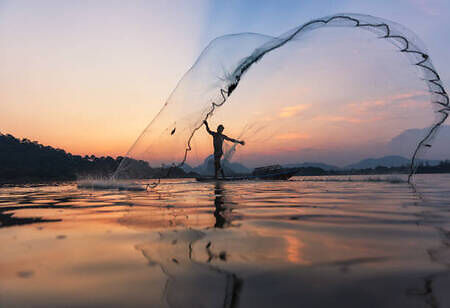
Fishermen: The Bee in the Heart of Dark Flower


Vehicle horns usually help save lives, infuriate other drivers, and cause sleepless nights for many city dwellers. But in our village, fishermen’s bike horns used to be alarm clocks for many like me in childhood. In the early mornings, fishermen rode their bikes or cycles through the village roads to sell the fish in the households. Selling fish was his occupation, but the horn that woke everyone used to remind them of their day's work. They used to bring the whole village a variety of fresh fish every day. I am sure many of your childhoods can relate to this rosy nostalgic experience. But often, the lives these fishermen and their families lead are not as rosy as the nostalgia. Living on the seashores, their whole family depends on the same business. But even their hard work never pays off.
Life of Fishermen
Fishermen set out to fish in the middle of the night or early in the morning. Motorized boats of the fishermen will be on the water before sunrise. They use metal hooks suspended by nylon thread to help them travel deep into the sea to catch fish. If they plan to catch the varieties of fishes, they must travel far in the sea, their large boats stocked with food and water to help them survive ten days at sea. Once they are back in the morning, the boat will be tugged to the shore by the fishermen, who venture out in groups of four, sharing the burden, cost, profits, and losses alike. They will be facing either of the following two scenarios. Some days, they will be blessed with plenty, but on other days they often return empty-handed, with a loss of about Rs. 400 that they spend on diesel to fuel the motors.
Fishermen sell fish to vendors if they can get a fair price, and most of the time, they end up selling fish in the villages directly. Sometimes wives also take separate routes to sell fish they procured. In the evenings, they are free to relax, watch TV, spend time with family and catch up on gossip over mending nets and preparing for the next day.
Women Depending on Fish Selling
At present Indian women are actively involved in the agriculture- and allied sectors. It is sculpted for the fisheries sector as well. For them, the sea is their collective mother who gives life to their fishing villages. According to the Handbook on Fisheries Statistics produced by the Government of India’s Department of Fisheries of the Ministry of Fisheries, Animal Husbandry and Dairying, fisherwomen account for 34.6 percent of the total fisher folk population that engages in various fishing and fisheries-related activities. In truth, however, the participation of fisherwomen is restricted throughout the various processes involving the fisheries sector, starting from the collection of fish and extending all the way to managerial and entrepreneurial positions. It seems clear that public policies and civil society support are not able to reach women in these communities effectively.
KC Rekha, a 45-year-old mother of four, will be sitting alone on an isolated beach of a Kerala fishing village at the crack of dawn, untangling a mess of nylon fishing nets on which her family’s livelihood depends. Rekha’s seawater-creased, sun-baked fingers finish the task before husband P Karthikeyan arrives for the couple’s voyage into the deep blue Arabian Sea on a small, old single-engine boat. She is the first woman in our country to get a fishing license.
Blue Economy Helping People to Lead their Life
Healthy oceans provide jobs and food, sustain economic growth, regulate the climate, and support the well-being of coastal communities. Millions of people worldwide, especially those who rely on healthy oceans as a source of jobs and food, underscoring the urgent need to use, manage and protect this natural resource sustainably. According to the OECD (Organization for Economic Co-operation and Development), oceans contribute $1.5 trillion annually in value-added to the overall economy, and this number could reach $3 trillion by 2030. The FAO (Food and Agricultural Organization) estimates that around 58.5 million people are employed worldwide in primary fish production alone – of which approximately 21 percent are women. Including subsistence and secondary-sector workers, and their dependents, it is estimated that about 600 million livelihoods depend at least partially on fisheries and aquaculture. Most are in developing countries and are small-scale, artisanal fishers and fish farmers.
How does a Fisherman Lead his life in Monsoon?
The sight of Mangalore port during monsoon is something to behold. There are rows of boats anchored and resting during the monsoon season. But, the fishermen continue to be busy as they are engaged in weaving something colorful. They work on big colorful fishing nets in port to catch large fish during the next fishing season. They will be busy weaving and stitching fishing nets even in their old age and leading independent lives by getting paid commensurately for their work. Ganesh Mogaveera, a resident of Malpe in Udupi District, who used to go fishing at the age of 10, recalls his past episodes of hunting large fishes with a sense of regret. He weaves a fish net, even though his eyesight is considerably poor. Fishing, passed down from generation to generation, has become their only means of living. That is why he passes the time absorbed in something connected to fishing, even at this old age.
Fishermans not only weave the new net but also stitch up the old nets and ready them for fishing. The key raw material used for fishing is the net itself which has gained the industry's status as the business of weaving clocks a turnover of crores of rupees.